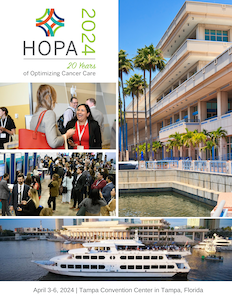Back
Trainee Research
Category: Management
(126) Immune Checkpoint Inhibitor Product Placement in Metastatic Non-Small Cell Lung Cancer at a Large Academic Medical Center
Friday, April 5, 2024
12:00 PM – 2:00 PM ET

Megan E. LoFaso James, PharmD
Resident
Cleveland Clinic
Strongsville, Ohio, United States
Presenting Author(s)
Poster Abstract: Background/Rationale:
The emergence of immune-checkpoint inhibitors (ICIs) has revolutionized the approach to several oncologic diseases including melanoma, gastric cancer, renal cell carcinoma, and non-small cell lung cancer over the last decade. Since 2011 with the approval of ipilimumab, the number of clinical trials for ICIs has increased significantly and the use of these agents as components of combination therapies has expanded to include not only other ICIs, but also traditional chemotherapy, radiation, and targeted agents.1 Due to the vast number of combination regimens and indications, there are several overlapping FDA approvals for these agents. This has led many in the oncology community to question whether these agents could be interchangeable as new products and indications are approved and offer potential for standardization, formulary simplification, and potential cost savings.2 One disease state that truly embodies the complexity of these approvals is non-small cell lung cancer (NSCLC) as it currently has seven ICIs (PD-1/PD-L1s: pembrolizumab, nivolumab, atezolizumab, cemiplimab, and durvalumab; CTLA-4: ipilimumab and tremelimumab) recommended for use in the frontline palliative setting.3 Therefore, the objective of this study is to evaluate the positioning of PD-1/PD-L1 products in a cohort of patients with metastatic non-small cell lung cancer (mNSCLC) at a large national comprehensive cancer center. The rationale for this exploration is to understand baseline use and prepare for the anticipated future approvals of additional PD-1/PD-L1 inhibitors.
Objective(s):
Primary: Describe the prescribing practices for front-line PD-1/PD-L1 agents in the context of NSCLC treated with palliative intent in a cohort of patients at a large national comprehensive cancer center.
Secondary
1. Describe adherence rates to institutional Care Paths for front-line PD-1/PD-L1 product prescribing in mNSCLC.
2. Describe potential cost savings benefit of PD-1/PD-L1 product preferencing.
Methods:
A retrospective chart review was conducted of patients > 18 years old receiving front-line palliative therapy with a PD-1/PD-L1 product for mNSCLC at Taussig Cancer Center between August 1, 2022-July 31, 2023. Patients were identified utilizing existing Epic ® functionality to pull regimen utilization based on known NSCLC protocol identification numbers. The primary outcome was the proportion of patients receiving individual PD-1/PD-L1 inhibitor-based regimens. The secondary outcomes were adherence rates to front-line institutional Care Paths and the costs of the associated therapies. Key data collection points include drug, treatment plan line of treatment, disease histology, and cytogenetics. Descriptive statistics were utilized for baseline characteristics in addition to the primary and secondary outcomes.
Results: In progress
Conclusions/
Discussion: In progress
References (must also be included in final poster): 1. Alsaab HO, Sau S, et al. PD-1 and PD-L1 Checkpoint Signaling Inhibition for Cancer Immunotherapy: Mechanism, Combinations, and Clinical Outcome. Front Pharmacol. 2017 Aug 23;8:561.
2. Pai-Scherf L, Blumenthal GM, et al. FDA Approval Summary: Pembrolizumab for Treatment of Metastatic Non-Small Cell Lung Cancer: First-Line Therapy and Beyond. Oncologist. 2017 Nov;22(11):1392-1399.
3. NCCN. Non-Small Cell Lung Cancer. Version 3.2023
The emergence of immune-checkpoint inhibitors (ICIs) has revolutionized the approach to several oncologic diseases including melanoma, gastric cancer, renal cell carcinoma, and non-small cell lung cancer over the last decade. Since 2011 with the approval of ipilimumab, the number of clinical trials for ICIs has increased significantly and the use of these agents as components of combination therapies has expanded to include not only other ICIs, but also traditional chemotherapy, radiation, and targeted agents.1 Due to the vast number of combination regimens and indications, there are several overlapping FDA approvals for these agents. This has led many in the oncology community to question whether these agents could be interchangeable as new products and indications are approved and offer potential for standardization, formulary simplification, and potential cost savings.2 One disease state that truly embodies the complexity of these approvals is non-small cell lung cancer (NSCLC) as it currently has seven ICIs (PD-1/PD-L1s: pembrolizumab, nivolumab, atezolizumab, cemiplimab, and durvalumab; CTLA-4: ipilimumab and tremelimumab) recommended for use in the frontline palliative setting.3 Therefore, the objective of this study is to evaluate the positioning of PD-1/PD-L1 products in a cohort of patients with metastatic non-small cell lung cancer (mNSCLC) at a large national comprehensive cancer center. The rationale for this exploration is to understand baseline use and prepare for the anticipated future approvals of additional PD-1/PD-L1 inhibitors.
Objective(s):
Primary: Describe the prescribing practices for front-line PD-1/PD-L1 agents in the context of NSCLC treated with palliative intent in a cohort of patients at a large national comprehensive cancer center.
Secondary
1. Describe adherence rates to institutional Care Paths for front-line PD-1/PD-L1 product prescribing in mNSCLC.
2. Describe potential cost savings benefit of PD-1/PD-L1 product preferencing.
Methods:
A retrospective chart review was conducted of patients > 18 years old receiving front-line palliative therapy with a PD-1/PD-L1 product for mNSCLC at Taussig Cancer Center between August 1, 2022-July 31, 2023. Patients were identified utilizing existing Epic ® functionality to pull regimen utilization based on known NSCLC protocol identification numbers. The primary outcome was the proportion of patients receiving individual PD-1/PD-L1 inhibitor-based regimens. The secondary outcomes were adherence rates to front-line institutional Care Paths and the costs of the associated therapies. Key data collection points include drug, treatment plan line of treatment, disease histology, and cytogenetics. Descriptive statistics were utilized for baseline characteristics in addition to the primary and secondary outcomes.
Results: In progress
Conclusions/
Discussion: In progress
References (must also be included in final poster): 1. Alsaab HO, Sau S, et al. PD-1 and PD-L1 Checkpoint Signaling Inhibition for Cancer Immunotherapy: Mechanism, Combinations, and Clinical Outcome. Front Pharmacol. 2017 Aug 23;8:561.
2. Pai-Scherf L, Blumenthal GM, et al. FDA Approval Summary: Pembrolizumab for Treatment of Metastatic Non-Small Cell Lung Cancer: First-Line Therapy and Beyond. Oncologist. 2017 Nov;22(11):1392-1399.
3. NCCN. Non-Small Cell Lung Cancer. Version 3.2023

